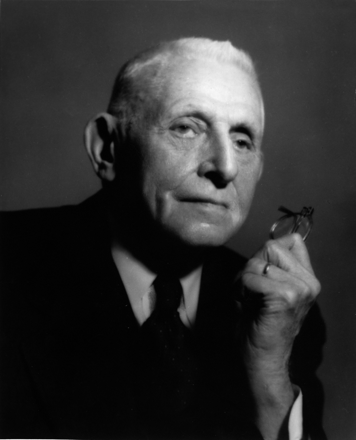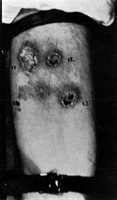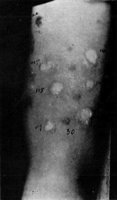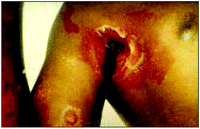Torald Sollmann’s Studies of Mustard Gas
- Brian M. Cox, PhD, Professor and Chair
In 1919, Torald Sollmann published two papers in the on the ability of selected solvents and absorbents to modify the severity of skin lesions induced by mustard gas (1,1′-thiobis[2-chlorethane], or dichloroethyl sulfide). Mustard gas, or sulfur mustard, is a vesicating agent that had recently been used on troops fighting in the First World War. Sollmann’s studies were unusual, at least by today’s standards, in that he chose to study the effects of this highly toxic compound on himself and on students who volunteered for the project. These studies did not provide insights into the mechanism of action of mustard gas or lead to the introduction of a novel antidote, and they certainly do not count among the major contributions to pharmacological research that arose from Sollmann’s long and distinguished career. Nevertheless, the papers are of interest because they shed light on the way that pharmacology was practiced by one of the founding members of the American Society for Pharmacology and Experimental Therapeutics. The willingness of Sollmann to expose both himself and his students to significant personal risk in the search for protective measures against mustard gas may also reflect the sense of fear and concern in the public at the use of chemical warfare in the twentieth century.
Torald Sollmann is probably best known to current ASPET members as the rather mysterious scientist recognized by the Sollmann Award. This Award, one of ASPET’s major prizes, is presented for significant contributions over many years to the advancement and extension of knowledge in the field of pharmacology. It commemorates the pioneering work of Torald Sollmann in the fields of pharmacological investigation and education. Sollmann was the second president of ASPET (1912–1914), succeeding Society founder John Jacob Abel [see (1)]. Sollmann will also remembered by many as the author of a monumental textbook of pharmacology, the Manual of Pharmacology, first published in 1917. The eighth and final edition, published in 1957, filled 1535 pages (4). This book offers a compulsively comprehensive survey of the actions in man and animals of a very wide range of therapeutic and toxic chemicals. I recall this text as one of the most detailed (and also heaviest) pharmacology texts in the library of my college in London during the 1960s.
Born in Germany in 1874, Sollmann emigrated, at the age of thirteen, to the US with his family. After premedical training in France, he studied medicine at Western Reserve University School of Medicine in Cleveland (now Case Western Reserve University), beginning an association with the school that extended for more than fifty years. He started out as an assistant to G.N. Stewart and stayed on the faculty in Cleveland for the rest of his long life. He was assigned to develop the Department of Pharmacology in Cleveland in 1898, becoming Professor of Pharmacology in 1904 and Dean of the School of Medicine from 1928 to 1944. He served on many national committees until he died, in 1965, at the age of ninety-one. He published almost 500 papers; seventy of these appeared, during the period between 1910 (2) and 1947 (3), in JPET.
In contrast to the broad and sometimes highly speculative rationales for their studies offered by many of today’s authors, Sollmann’s motivation for conducting these experiments is not clearly stated. The opening is laconic: “Dichoroethylsulphid, as is generally known, is a very powerful and peculiar irritant.” He could be talking about poison ivy. Only three pages later, in the third paragraph of the Methods section, and after noting that the effects of mustard gas on animal skin were very different from its effects on human skin, does Sollmann hint that these studies might have a broader significance than a simple problem of drug action: “The urgency of the problem at the time seemed to justify experiments on human subjects;” this terse justification would perhaps fail to pass muster with a contemporary IRB.
In 1917, American troops were deployed in Europe for the first time as the US entered the First World War. One of the many issues concerning US public opinion at this time was the knowledge that toxic chemical agents were being used to reduce the military capabilities and destroy the morale of Allied troops in the trenches. In 1915 and 1916, chlorine gas was first used by German forces, with initially devastating effects on unprepared troops. Later, phosgene and other gases in addition to chlorine were used by both sides. The toxic gases proved difficult to control, however, and although many troops suffered from exposure to chlorine, it was generally not a significant military factor. In July of 1917, German forces began using mustard gas on British troops at Ypres. Within the next three weeks, there were 14,000 non-fatal casualties and about 500 deaths attributed to mustard gas (5). Allied forces rapidly followed in deploying the new agent.
Mustard “gas” is a volatile liquid that was disbursed as an aerosol released from explosive devices detonated over enemy troops and trenches. The volatile liquid sticks to skin and other surfaces to which it is exposed. It contaminates the ground over which it has been dispersed for several hours to days, extending the risk of personnel exposure well after its initial dispersal. The effects of mustard gas are disturbing in part because they do not develop immediately, but rather over a matter of hours or days. In the confusion of life in the trenches, it was easy to be unaware at the time of a personal exposure; however, after a period of several hours, unpleasant and frightening effects became apparent, including progressively severe blistering and skin ulceration. Exposed troops often were temporarily blinded (for days to weeks), owing to vesication, swelling, and subsequent closure of the eyelids. Those unfortunate enough to inhale mustard gas were subject to gruesome damage of the lungs and upper airway, often accompanied by pulmonary edema, intractable vomiting, and death. These effects had a devastating effect on troop morale, and were soon well known to the general public. John Singer Sargent’s Gassed was based on his visit to the front lines in 1918. It depicts a group of blinded soldiers being led through a gas-filled battlefield by a sighted orderly after their exposure to mustard gas.
In 1917, Sollmann had published a paper in JPET with the title “Endermal Pharmacology” (6), in which he examined the effects of a number of drugs in common use when applied directly to human skin. Although the origins of Sollmann’s interest in mustard gas is unclear, it is possible that this 1917 paper, along with growing public concern over the new and highly toxic warfare agent, precipitated Sollmann’s decision to evaluate the effects of mustard gas on skin. Having concluded that animal skin did not provide a good model for the clinical effects of mustard gas, he decided to use human volunteers. He names six students and himself as volunteer experimental subjects for these studies.
The experimental method employed in these studies was to expose small areas of the forearm either to liquid applied directly to the skin or to mustard gas vapor from a small glass vial [(7); see also Sollmann’s original Figure legends, shown here in Figure 1⇓]. Exposure to a controlled amount of the vapor appeared to give the most consistent lesions. Because the objective was to find agents that might be applied to the skin to reduce or prevent the lesions induced by mustard gas, discrete areas of skin were pre-treated with solvents, absorbent ointments, or powders. Vesication usually commenced within one to three days, progressing in some cases to “painful ulceration,” reaching a peak at around ten days with “gangrene of the entire thickness of the skin” occurring in a few cases. Healing to a “practically stationary condition” occurred in about four to seven weeks (7). Examples of some of the more severe skin lesions observed in this study are shown in Figure 1⇓. In a few of the published images, the name of a subject receiving a specific treatment is listed. One of the illustrations in the paper apparently depicts Sollmann’s own lesioned forearm after various treatments (Figure 1⇓, right panel).
The results observed for potential protective agents were neither surprising nor encouraging; the solubility of mustard gas in the solvent of interest correlated with protection against blistering. Water made the lesion worse; petroleum jelly (in the form of Vaseline) offered partial protection. Non-aqueous absorbent ointments and powders of kaolin, fuller’s earth, and charcoal offered more protection, with “coconut charcoal” being the most effective. Unfortunately, it proved difficult to cover all exposed areas of skin with a layer of these powders sufficiently thick to provide useful protection under field conditions. None of the treatments were completely protective, and by the time of publication, it was already known that appropriate clothing and masks offered adequate protection. Although protective suits were uncomfortable and inconvenient to wear, resulting in heat stroke in hot weather, coating the skin with coconut charcoal or Vaseline was not a practical alternative.
The second study (8), published together with the first, evaluated whether a prior exposure to mustard gas could cause sensitization to subsequent exposure. This investigation seems to be have been initiated by reports of “sores” and “conjunctival and laryngeal catarrh” in workers manufacturing mustard gas in the US, and also by Sollmann’s observations that areas of his own skin that had previously been exposed to mustard gas became hypersensitive to subsequent exposures. It had also been noted that severe skin lesions caused by mustard gas on the battlefield appeared to heal more slowly than similarly severe skin lesions caused by other means. Sollmann’s investigation in this case included a soldier who had suffered several accidental exposures while working for three months on mustard gas production; occupational health and safety standards were obviously less rigorous than today. Sollmann tested the effects of applied mustard gas on this pre-exposed soldier’s skin, but eventually decided that he could not observe any increase in sensitivity to the test exposure. Sollmann concluded that although “healed” areas remain “oversusceptible” to injury by mustard gas, adjacent non-injured areas had normal sensitivity. We can conclude that neither of Sollmann’s two studies led to the identification of novel and effective protective methods against mustard gas.2
The mechanisms underlying the toxic effects of mustard gas are complex. Even before Sollmann’s 1919 studies, it had been speculated by E.K. Marshall and colleagues, also in JPET, that mustard sulfur is hydrolyzed in tissues to release hydrochloric acid, which was hypothesized to account for the observed cytotoxicity (11). This hypothesis was later rejected because the time course of acid release does not correlate well with the onset of vesication (12). After summarizing earlier speculations, Sollmann, in the 1957 edition of his textbook, cites the work of Gilman and Phillips (10) as providing the mechanistic basis for the toxicity of sulfur mustards. Specifically, mustard gas cyclizes to form a highly reactive ethylene sulfonium ion, whereas the chemically related form an almost equally reactive ethylene imonium species. These highly reactive ions decay in water, but in contact with tissues they preferentially alkylate sulfhydryl, α-amino, ε-amino, imidazole, and other reactive groups of proteins and DNA molecules. Mustard gas can also interact with many other cellular components (13).
The public reacted to the use of chemical warfare agents with increasing anger as the horrors of the war escalated. Public distaste was also fueled in part by Sargent’s painting, first displayed at the Royal Academy in London in 1919, and by Wilfred Owen’s poem Dulce et decorum est (see above). Although all major parties in the First World War had signed the Hague Conference of 1899, requiring signatories to abstain from the use of projectiles for “the diffusion of asphyxiating or deleterious agents,” German forces first, followed by the Allies, nevertheless used various chemical weapons extensively in 1917 and 1918. After the war, a general public outcry led to consideration of the issue by the League of Nations. Eventually, the major powers all became signatories to the Geneva Convention on Poisonous Gases of 1925, although at the same time each country continued active research programs on the development of novel chemical warfare agents, leading to ever more lethal effects.
Although Italy used mustard gas in Ethiopia in 1935, and Japan used it in China in 1936, chemical agents were not used by the combatants of World War II. It is said that Adolf Hitler, who was gassed (probably by mustard gas) and suffered temporary blindness during his service in the German army in 1917, barred German deployment of chemical weapons in World War II as a result of his own experience; however, there appears to be little documented evidence to confirm that Hitler played any role in the decision not to use chemical weapons (5).
Mustard gas was resurrected by Iraqi forces under Saddam Hussein in the 1980s for use against Iranian forces, with over 100,000 poorly protected soldiers suffering severe and debilitating injuries as a result. Roughly one-third of these soldiers continue to suffer long-lasting consequences of exposure (13). Mustard gas and other agents did not lead to a military victory for Iraq, although their use may have prevented defeat by a more numerous enemy. Images of the injuries sustained by exposed Iranian personnel confirm (14) the harsh lessons learned, some ninety years ago, in the trenches of World War I (Figure 2⇓).
Figures from Sollmann’s 1919 paper on mustard gas(7). The photograph on the left (originally, Sollmann’s Figure 2⇓), shows some of the more severe injuries observed in this study. The photograph on the right (originally, Sollmann’s Figure 5), shows Sollmann’s own forearm, demonstrating partial protection against mustard gas by selected agents (as well as Sollmann’s personal commitment to his research).
Effects of mustard gas on an Iranian soldier from the Iraq–Iran war of 1982. Reproduced with permission from the British Journal of Medicine (14).
Acknowledgments
The author wishes to thank LTC Jurgen von Bredow, PhD, USA (retired), now with the Food and Drug Administration, for helpful discussions and for providing access to texts on the use of mustard gas in warfare, and Ms Linda Spitzer of the USU Learning Resource Center for help in locating copies of the first and eighth editions of Sollmann’s Manual of Pharmacology. The opinions and assertions contained herein are solely the opinion of the author and are not to be construed as official or reflecting the views of the Uniformed Services University of the Health Sciences or the Department of Defense or the Government of the United States.
Footnotes
-
↵2 Another distinguished member of ASPET, Alfred Gilman, then working with several other well-known pharmacologists at Edgewood Arsenal in Maryland, first recognized the possible therapeutic applications of the cytotoxic actions of sulfur and nitrogen mustards as anti-neoplastic agents in the therapy of leukemias and other cancers (9, 10). It was soon recognized that the nitrogen mustards were more convenient and less toxic than sulfur mustards as therapeutic agents. Related alkylating agents that are still in use today in cancer chemotherapy include cyclophosphamide and melphalan.
-
1 This article is part of the From the Archives series published in honor of the ASPET Centennial (1908–2008).
- © American Society for Pharmacology and Experimental Theraputics 2007
References
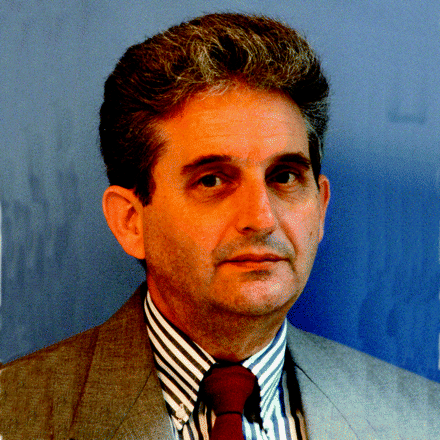
Brian M. Cox, PhD, Professor and Chair of the Department of Pharmacology at the Uniformed Services University of the Health Sciences in Bethesda, MD. He is also the Chair of the Board of Publications Trustees of ASPET.

